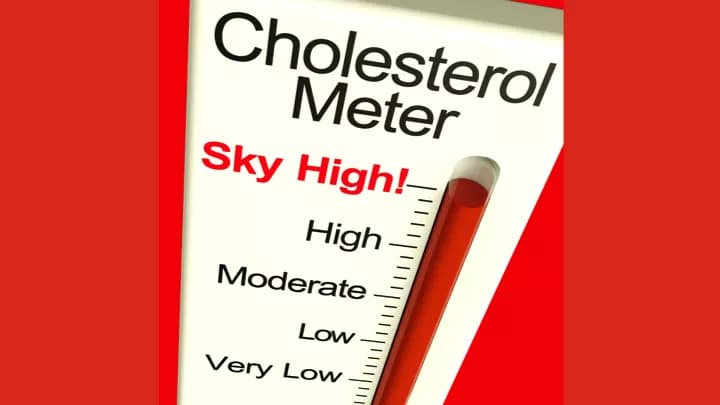There are 3 types of lipoprotein particles that are distinguished by their density, contents, and functions. The three types are very low-density lipoproteins (VLDLs), low-density lipoproteins (LDLs), and high-density lipoproteins (HDLs).
When a fat containing meal is ingested, the majority of the fats (triacylglycerols) are broken down in the small intestine by bile salts released by the pancreas. Once broken down into free fatty acids, they are absorbed through the intestinal walls and repackaged again as triacylglycerols into particles called chylomicrons. Chylomicrons contain triacylglycerols and cholesterol among other fat soluble nutrients. These particles are released into the lymphatic system and eventually enter the bloodstream. In blood vessels, fatty acids are released from the chylomicrons by enzymes to be used by cells as energy. The remnants of the chylomicrons enter the liver, which absorbs the remaining fat and cholesterol.
Once the fat and cholesterol is taken up by the liver, it is stored until the body needs energy between meals or during fasting. Fats and cholesterol are sent back into the bloodstream by the liver in VLDLs. VLDLs have the lowest density, but the highest percentage of fats inside. Once enzymes release fats from VLDLs for use as energy, they turn into an intermediate density lipoprotein, and finally into LDLs. LDL is the acronym for low-density lipoproteins, which are formed from very low-density lipoprotein particles released by the liver.
LDLs have the second lowest density, but the highest percentage of cholesterol. When there are normal levels of LDL in blood, they help deliver cholesterol to cells to be used for many different important functions. However, if LDL levels are too high then the lipoproteins can stick together outside artery walls. This can activate immune cells called macrophages which try to clear them away. If macrophages take up too much cholesterol they can die and damage nearby vessel walls. Additionally, the cells along with the cholesterol they contained can form plaques on the vessel wall, which can lead to blockages. This is why LDL is also known as “bad” cholesterol.
Plaque buildup on the blood vessel walls is also known as atherosclerosis. The buildup of plaque in arteries narrows their diameter and obstructs blood flow. If a blood vessel to the heart becomes completely blocked off, it can cause a heart attack. If a blood vessel in the brain is blocked, it can cause a stroke. Blockages in other arteries can cause discomfort and swelling along with other problems. This risk of developing atherosclerosis is increased by diets high in fat and cholesterol, smoking, high blood pressure, diabetes, obesity, and a sedentary lifestyle.
HDL is known as “good” cholesterol, because it is sent out by the liver to collect cholesterol from the blood stream to bring back to the liver, adrenal glands, and gonads. This helps to reduce circulating cholesterol and prevent plaque buildup and heart disease. Unlike LDL, HDL can lower your risk of developing atherosclerosis.
Atherosclerosis can be prevented by making changes to your diet and lifestyle. By eating a diet lower in saturated fats and cholesterol, you help to lower your LDL levels. Exercising can help lower the amount of fat circulating in your bloodstream, lower cholesterol levels, and lower your weight. If you do smoke, you are also at higher risk for atherosclerosis, and so quitting is an important part of lowering your risk and improving overall health. If you have diabetes, proper management is also important for preventing heart disease. Finally, regular checkups with your doctor can ensure that the signs of atherosclerosis are caught as early as possible and that your cholesterol levels are properly managed. People with unmanageable cholesterol may need to be prescribed medications to prevent cholesterol buildup.
References and Information Sources used for the Article:
http://www.urmc.rochester.edu/encyclopedia/content.aspx?ContentTypeID=1&ContentID=1583 (accessed on April 2, 2016)
http://www.uchospitals.edu/online-library/content=P00197 (accessed on April 2, 2016)
http://www.cdc.gov/cholesterol/ldl_hdl.htm (accessed on April 2, 2016)
"Lehninger Principles of Biochemistry, Sixth Edition" by Nelson and Cox W. H. Freeman Publishing, 2012
Manninen, V., Tenkanen, L., Koskinen, P., Huttunen, J. K., Mänttäri, M., Heinonen, O. P., & Frick, M. H. (1992). Joint effects of serum triglyceride and LDL cholesterol and HDL cholesterol concentrations on coronary heart disease risk in the Helsinki Heart Study. Implications for treatment. Circulation, 85(1), 37-45.
Mackness, M. I., Arrol, S., Abbott, C., & Durrington, P. N. (1993). Protection of low-density lipoprotein against oxidative modification by high-density lipoprotein associated paraoxonase. Atherosclerosis, 104(1), 129-135.
Lemieux, I., Lamarche, B., Couillard, C., Pascot, A., Cantin, B., Bergeron, J., ... & Després, J. P. (2001). Total cholesterol/HDL cholesterol ratio vs LDL cholesterol/HDL cholesterol ratio as indices of ischemic heart disease risk in men: the Quebec Cardiovascular Study. Archives of internal medicine, 161(22), 2685-2692.
Sacks, F. M., Tonkin, A. M., Craven, T., Pfeffer, M. A., Shepherd, J., Keech, A., ... & Braunwald, E. (2002). Coronary heart disease in patients with low LDL-cholesterol benefit of pravastatin in diabetics and enhanced role for HDL-cholesterol and triglycerides as risk factors. Circulation, 105(12), 1424-1428.
Ferrara, A., Barrett-Connor, E., & Shan, J. (1997). Total, LDL, and HDL cholesterol decrease with age in older men and women The Rancho Bernardo Study 1984–1994. Circulation, 96(1), 37-43.
Related Articles
Test Your Knowledge
Asked by users
Related Centers
Related Specialties
Related Physicians
Related Procedures
Related Resources
Join DoveHubs
and connect with fellow professionals


0 Comments
Please log in to post a comment.